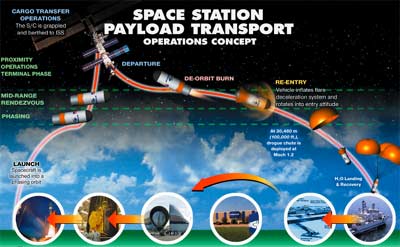NASA tries commercialization againby Taylor Dinerman
|
| They are asking companies to do an awful lot for the $500 million, and in some ways this is structured the same way the disastrous X-33 program was. |
This time they say they want to give private industry a set of objectives and then let them decide how to achieve them. For example, the so-called “Capability B” internal (pressurized) cargo delivery and disposal requires that the private entity deliver up to 8400 kilograms of cargo per year, including 1100 kg of water and 300 kg of atmospheric gas. They want two to eight flights per year “to be optimized by the participant” and a “mission reliability of at least 95% for high value cargo at a 50% confidence level.” Any company that can achieve this will have proven that it can truly handle complex and highly demanding orbital missions and will be in a position to bid on future NASA low Earth orbit (LEO) projects or to work on private manned facilities such as Bigelow Aerospace’s “space hotel”.
One of the most interesting aspects of Brant Sponberg’s presentations to both the NASA Advisory Council and at the FAA’s Office of Commercial Space Transportation Conference was the idea that somebody might want to build a private refueling station in LEO where NASA’s Moon missions could stop and “gas up” before translunar injection. This would allow a greater useful payload to ride into orbit on shuttle-derived heavy-lift vehicles. The lunar vehicle could potentially rendezvous with the CEV at the refueling facility as well. This is a chance for someone, maybe Bigelow, to build the kind of space station in near-equatorial orbit that the ISS could and should have been.
In the world of government contracting COTS usually stands for “commercial off the shelf”. These are items that can be bought simply and without having to be built to military specifications (Mil Spec) or to similar requirements. Most of the time COTS equipment has served well, such as the all-terrain vehicles used by the Special Forces in Afghanistan. For NASA, however, COTS in this sense is not really an option. US companies have no off-the-shelf orbital cargo delivery systems. Yet this is not true of the rest of the world.
| Like Lucy with the football, NASA expects the small companies to follow the example of Charlie Brown and to try and kick the ball that, for the best reasons in the world, they will pull up at the last minute. Maybe NASA will not pull the football this time, but then again there are no guarantees that they will not. |
NASA says that foreign content will be allowed “consistent with US law and policy.” This may be a good sign for the big established aerospace companies who have battalions of lawyers and regulatory experts on call, but for small startup ventures this would seem to put most foreign collaboration off-limits. If Boeing or Lockheed wants to start launching supplies to the ISS on either a Delta 4 or an Atlas 5, using an “Americanized” Progress capsule, they have the clout and the engineering and legal expertise to do so. The same thing goes for a modified European ATV or even a mostly new vehicle, perhaps based on a pressurized structure made in Italy by Alcatel Alenia Space.
Many of the smaller space companies have been through this before, most recently with the on-again, off-again methane engine project. Like Lucy with the football, NASA expects the small companies to follow the example of Charlie Brown and to try and kick the ball that, for the best reasons in the world, they will pull up at the last minute. Maybe NASA will not pull the football this time, but then again there are no guarantees that they will not.
On paper the COTS project looks good, but NASA should be ready to answer lots of questions from skeptics who have seen previous commercialization schemes fail before. NASA is on its way back to the Moon and is showing signs that it is ready to be single-minded about getting there. This may be a good sign, but it doesn’t mean much to the little guys who’ve been burned too often in the past.
